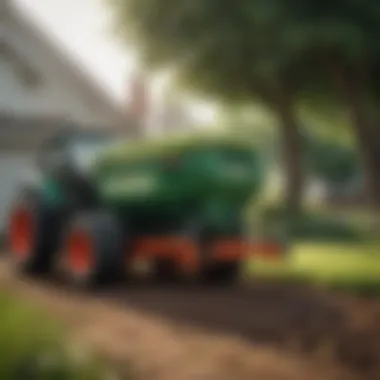A Complete Guide to Lawn Fertilization Techniques


Intro
Lawn care is an essential part of maintaining an attractive home exterior. A well-nourished lawn not only enhances curb appeal but also contributes to a healthy environment. Understanding how to effectively spread fertilizer is a crucial aspect that can significantly influence the health of grasses and plants.
Throughout this guide, we will explore various methodologies for optimal fertilizer application, including different types of fertilizers available on the market. This information will equip both novice and experienced gardeners with the knowledge they need to make informed decisions.
Key Insights and Trends
Current Trends in Lawn Care
As homeowners increasingly value outdoor spaces, the focus on lawn care has intensified in recent years. Organic fertilizers have surged in popularity. Their benefits derive from naturally sourced nutrients that improve soil quality without the risk of chemical burn. Gardeners tend to favor products that promote long-term soil health over immediate but less sustainable results.
Popular Gardening Techniques of the Season
Another evident trend is the adoption of precision application techniques using tools like spreaders or sprayers. Homeowners are becoming more scientific in their lawn care approach. These techniques ensure even distribution of nutrients, minimizing waste and maximizing the effectiveness of fertilizer.
"Efficient fertilizer application significantly enhances plant health and overall lawn vitality, providing both aesthetic and ecological benefits."
Understanding Fertilizer Types
Fertilizers fall into two main categories: synthetic and organic. Synthetic fertilizers contain chemically formulated nutrients, while organic ones are derived from natural substances like compost or manure. Homeowners should consider their lawn’s specific needs when selecting fertilizer types, as well as the environmental impact of their choices.
Key Factors in Choosing Fertilizers
- Nutrient content: Understanding the numbers on fertilizer packages (N-P-K ratio) is essential.
- Application timing: Fertilization is most effective during the grass’s growing season.
- Soil condition: Conducting soil tests can provide insights into nutrient deficiencies.
Practical Tips and How-To Guides
Step-by-Step Guide to Spreading Fertilizer
- Prepare Your Lawn: Mow the grass to a suitable height. Remove any debris.
- Determine the Right Fertilizer: Anti-check the N-P-K ratio based on your lawn’s needs.
- Read Instructions Carefully: Different fertilizers have unique application methods.
- Use a Spreader: Hand-held or push spreaders can ensure even distribution.
- Water Your Lawn: Lightly watering after application helps in nutrient absorption.
- Monitor Results: Keep an eye on your lawn's growth and make adjustments for future applications.
Best Practices for Application
- Early morning or late afternoon are optimal times for application to avoid evaporation.
- Avoid windy days to minimize the risk of uneven distribution.
By following these steps, you can enhance your lawn's health and appearance effectively. The journey to a thriving lawn begins with informed decisions about fertilizer and application methods.
Understanding Lawn Fertilization
Understanding lawn fertilization is pivotal for anyone aiming to cultivate a healthy, vibrant lawn. This section will illuminate various essential aspects that influence effective fertilization. The significance of fertilization does not merely rest on enhancing the aesthetic appeal; it plays a vital role in maintaining the health of grass and supporting robust growth. A well-fertilized lawn can withstand diseases, drought, and pest infestations more effectively. It also promotes a lush green turf, which enhances the overall landscape.
Importance of Fertilization
Fertilization is foundational in providing grasses with the nutrients necessary for optimal health. Grass requires a consistent supply of essential nutrients such as nitrogen, phosphorus, and potassium—collectively known as N-P-K. Each plays a specific role. Nitrogen promotes vigorous growth and enhances the green color of grass. Phosphorus supports root development, while potassium aids overall health and disease resistance. Without adequate fertilization, grasses can become weak, leading to patchiness, discoloration, and vulnerability to stressors.
Nutrient Requirements for Lawns
Lawns, like any other crops, have particular nutrient needs. These requirements vary based on grass type and soil composition. It is crucial to understand the specific needs of the grass species being cultivated. Conducting a soil test can provide insight into nutrient deficiencies or excesses, allowing for precise fertilization practices. Generally, most lawns benefit from a balanced approach that supplies all essential nutrients, ensuring lush growth over time.
Types of Fertilizers
Fertilizers can be categorized into three main types: organic, inorganic, and the distinction between slow-release and fast-release fertilizers. Each type has distinct characteristics and applications that serve varied lawn care goals.
Organic Fertilizers
Organic fertilizers are derived from natural sources such as animal manure, compost, or plant matter. They contribute to soil health by increasing microbial activity and improving soil structure. This type of fertilizer releases nutrients slowly, providing a steady supply over time. A major advantage of organic fertilizers is their low risk of nutrient runoff, making them more environmentally friendly. However, their nutrient concentrations are typically lower compared to inorganic fertilizers, which may require more frequent applications.
Inorganic Fertilizers
Inorganic fertilizers are synthetically manufactured and often contain higher concentrations of nutrients. They work quickly to deliver nutrients to the grass, making them an attractive option for rapid lawn recovery, especially after damage or stress. The key characteristic of inorganic fertilizers is their precise N-P-K ratios, allowing for targeted nutrient delivery. However, the risk of nutrient runoff is higher with these products, particularly if applied improperly, which can lead to environmental issues.


Slow-Release vs. Fast-Release
Choosing between slow-release and fast-release fertilizers hinges on specific lawn needs and goals. Slow-release fertilizers gradually provide nutrients over an extended period, reducing the frequency of application and minimizing the risk of nutrient leaching. Fast-release fertilizers deliver nutrients immediately, suitable for quick fixes or revitalizing a struggling lawn. However, this can lead to a risk of fertilizer burn if not applied carefully. Understanding the desired outcome will guide the choice between these types effectively.
Choosing the Right Fertilizer
Choosing the right fertilizer is crucial for achieving a healthy, vibrant lawn. The proper fertilizer promotes robust grass growth and optimizes nutrient intake. It also affects soil health. Making informed choices saves time and keeps costs down. Understanding soil conditions, grass types, and nutrient needs is essential.
Analyzing Soil Health
The foundation of effective fertilization begins with soil health analysis. Homeowners should conduct a soil test. This test reveals pH levels and nutrient content. Knowing the soil's condition allows for better fertilizer selection. For example, if nitrogen is lacking, a nitrogen-rich fertilizer can be used.
Soil testing kits are widely available. They usually include detailed instructions. Homeowners can also send samples to a lab for more accurate analysis. In addition to nutrient levels, understanding soil texture is beneficial. Sandy soils drain quickly, while clay soils retain moisture. This knowledge helps in selecting the right fertilizer type and application rate.
Understanding N-P-K Ratios
After determining soil health, it's essential to understand N-P-K ratios. The N-P-K ratio refers to Nitrogen (N), Phosphorus (P), and Potassium (K) present in fertilizers. Every plant requires these nutrients in specific amounts.
- Nitrogen: Promotes leaf growth and vibrant color.
- Phosphorus: Aids root development and flowering.
- Potassium: Enhances overall health and disease resistance.
For instance, a fertilizer with a ratio of 10-10-10 contains equal parts of each nutrient. Selecting a fertilizer with the right N-P-K ratio based on specific lawn needs is vital. An imbalance can lead to poor growth or even damage. Always check the package for these ratios before purchasing.
Selecting Fertilizer for Specific Grass Types
Different grass types have unique nutrient requirements. Warm-season grasses, like Bermuda and Zoysia, need more nitrogen during growth periods. Cool-season grasses, such as Kentucky bluegrass, require higher phosphorus levels, especially in spring. When selecting a fertilizer, consider the grass species in your lawn.
To enhance your lawn's health, here are key factors to consider:
- Growth Cycle: Identify when each grass type is most active.
- Climate: Local climate conditions can affect nutrient needs.
- Foot Traffic: High traffic areas may require more robust fertilization.
"Understanding your specific grass types helps tailor your lawn care strategy effectively."
By aligning fertilizer selection with grass type needs, homeowners can effectively improve their lawn's health. This knowledge leads to efficient growth and a beautiful outdoor space.
Timing Your Fertilization
Timing your fertilization is a critical factor in ensuring the health and vigor of your lawn. Fertilizer application at the right moment can lead to optimal growth and prevent potential issues related to nutrient deficiencies or excesses. The success of your lawn care efforts hinges upon recognizing the seasons, understanding specific application windows, and acknowledging how weather conditions can greatly impact the efficiency of fertilizer uptake.
Seasonal Considerations
The seasons have distinct impacts on grass growth and nutrient requirements. Generally, grass can be categorized as cool-season or warm-season, each thriving during different parts of the year.
- Cool-season grasses like Kentucky bluegrass and fescue flourish in the spring and fall. Apply fertilizer in early spring and early fall to promote vigorous growth.
- Warm-season grasses such as Bermuda and Zoysia peak during summer. Fertilization in late spring and summer ensures robust growth.
It's essential to adjust fertilizer type and quantity according to seasonal needs. Misalignment in timing can stress the grass and could result in inadequate growth or even lawn damage.
Optimal Application Windows
Identifying the optimal windows for application enhances the efficacy of fertilization. This often correlates with grass growth patterns.
- For cool-season grasses, the best time is during their active growth phase, typically in April or September. Fertilize when soil temperatures reach about 50°F (10°C).
- For warm-season grasses, wait until soil temperatures hit a higher range, about 65°F (18°C), which usually falls in May.
Regularly monitoring grass growth and adjusting application windows as necessary can help in achieving the desired lawn quality.
Weather Conditions for Fertilization
Weather plays a significant role in the success of fertilizer application. Several elements should be considered before proceeding.
- Rain: A light rain within a few days after fertilization can help in nutrient absorption. However, extreme rainfall can wash away the fertilizer, leading to runoff and nutrient loss.
- Temperature: Applying fertilizer during extremely hot or dry conditions can stress the grass. The best temperature for application generally lies between 60°F to 80°F (15 to 27°C).
- Wind: Avoid fertilizing on windy days as it may cause uneven distribution, leading to possible damage in certain areas.
Considering the weather before proceeding with fertilization is essential. Recognizing these various factors helps homeowners make informed decisions for a thriving lawn.


Methods for Spreading Fertilizer
Understanding the methods for spreading fertilizer is critical to achieving a healthy lawn. Different techniques have distinct implications for how efficiently nutrients reach grass roots and how uniformly they are distributed across the area. The choice of method can affect not only the success of the fertilization but also your overall lawn management. Each technique comes with its own benefits and considerations, making it essential to match the method to your specific lawn needs and conditions.
Manual Spreading Techniques
Manual spreading techniques are often used for smaller lawns or specific patches that require targeted fertilization. This approach involves physically applying the fertilizer by hand, allowing for greater flexibility in application. Homeowners can easily control the amount of fertilizer used, reducing the risk of over-fertilization.
- Application Control: This technique allows for a more hands-on approach. Users can adjust their application based on the visible condition of the grass.
- Targeted Areas: It is particularly effective in treating specific areas that may be unhealthy or underperforming, ensuring that nutrients are focused where they are most needed.
- Cost-Effective: Manual spreading requires no additional equipment, making it accessible for many homeowners looking to improve their lawn without incurring significant costs.
However, manual methods can be labor-intensive, particularly for larger areas. Additionally, achieving uniform coverage requires practice and attention. This method may not be ideal for extensive lawns due to the time and effort required.
Using a Broadcast Spreader
A broadcast spreader is a mechanical device designed to distribute granules of fertilizer evenly across a lawn. This method is well-suited for larger areas, ensuring a consistent application that can enhance overall lawn health and aesthetics. Key benefits include:
- Efficiency: The broadcast spreader greatly reduces the time spent on fertilization compared to manual methods. This enables homeowners to cover large areas relatively quickly.
- Uniform Distribution: The design helps achieve a more uniform distribution of fertilizer, minimizing the risk of patchy growth and associated problems.
- Adjustability: Many modern spreaders come with adjustable settings. This allows users to control the rate of application based on the specific fertilizer being used and the needs of the lawn.
However, users should pay attention to calibration settings. Miscalibration can lead to over-application or under-application, causing potential damage or nutritional deficiencies in the grass.
Liquid Fertilizer Application
Liquid fertilizer is another effective approach for lawn fertilization, providing a quick nutrient uptake for grass. This method involves applying a liquid solution, which can be beneficial for rapidly growing lawns or for specific treatments. Among the advantages are:
- Quick Absorption: Liquid fertilizers are readily available to grass roots and can lead to immediate visible results.
- Versatility: This method can be used with various types of liquid fertilizers, including organic options that appeal to environmentally conscious homeowners.
- Application Flexibility: Liquid fertilizer can be applied using a hose-end sprayer or a backpack sprayer, allowing for easy use over different lawn sizes and types.
Nevertheless, effective application requires a clear understanding of concentration and coverage. Over-application can result in run-off and environmental issues, while under-application might lead to insufficient nutrient delivery.
"The choice of fertilization method directly influences the health of your lawn and the efficiency of nutrient delivery."
In summary, choosing the right method for spreading fertilizer is crucial for maximizing nutrient application and promoting lawn health. Whether opting for manual techniques, utilizing a broadcast spreader, or applying liquid fertilizers, careful consideration will lead to a more vibrant lawn.
Best Practices for Fertilizer Application
Applying fertilizer effectively is vital for maintaining a healthy lawn. Understanding best practices in fertilizer application can improve nutrient uptake and promote strong grass growth. By following these principles, homeowners can ensure their lawn receives the right treatment at the right time, ultimately leading to a lush green space they can be proud of.
Calculating Coverage Area
To apply fertilizer correctly, it is imperative to calculate the coverage area of your lawn. This involves measuring the total square footage of the area that needs fertilization.
- Measure Length and Width: Measure the length and width of your lawn. For irregular shapes, break them down into smaller rectangles or circles and calculate each area separately, then sum them up.
- Use Online Calculators: Numerous online tools can help simplify the calculation process, providing instant estimations based on input dimensions.
- Consider Fertilizer Packaging: Fertilizer bags typically have coverage information. Knowing this helps to determine how much product you will need based on the calculated area.
By correctly calculating the coverage area, you avoid wasting fertilizer, which can lead to environmental runoff and increased costs.
Avoiding Overlap and Gaps
When applying fertilizer, ensuring even coverage is essential. Overlap can lead to burnt patches, while gaps can result in inadequate nourishment for your lawn. Here are best practices to avoid these issues:
- Use Markers: If you're applying fertilizer manually, use markers like stakes to guide your path.
- Follow a Pattern: Spread in a systematic pattern, such as a crisscross or circular method, to cover the entire area without missing or overlapping.
- Adjust Spreader Settings: If using a broadcast spreader, adjust the settings as needed to suit the width of your swath. Understanding the machine you use is key to minimizing overlap.
A uniform application leads to healthier grass and reduces unnecessary fertilizer use.
Safety Precautions
When handling fertilizers, safety should be a major concern. Following safety precautions protects not only you but also children and pets nearby.
Protecting Pets and Children
Fertilizers can pose health risks to pets and children if ingested or come into contact with their skin. To maximize safety:
- Time of Application: Apply fertilizer when pets and children are indoors. Consider applications in the evening or during cooler parts of the day.
- Read Labels: Always check product labels for safety instructions regarding re-entry times after application. This guidance helps prevent exposure.
- Choose Safe Products: Opt for organic fertilizers when possible. They tend to have lower toxicity levels and are generally safer around pets and children.


By being careful in this regard, the overall approach to lawn care can substantially reduce risk and enhance peace of mind for homeowners.
Using Protective Gear
Wearing protective gear while handling fertilizers prevents exposure to potentially harmful chemicals.
- Standard Gear: This can include gloves, masks, and goggles. They protect your skin and lungs from harmful substances in fertilizers.
- Respirators: For those working with powdered fertilizers or in enclosed spaces, a respirator may be advisable to avoid inhaling fine particles.
- Follow Specific Guidelines: Each fertilizer product may have different recommendations concerning safety gear. Always adhere to these rules.
Protective gear is crucial and supports the goal of safe lawn care practices. Proper precautions can mitigate health risks effectively.
By adhering to best practices in fertilizer application, homeowners can maintain not only a thriving lawn but also contribute positively toward environmental health.
Post-Application Care
Post-application care is a critical phase in the lawn fertilization process. It ensures that the efforts put into fertilization yield the desired results. After applying fertilizer, the right care can promote optimal nutrient absorption and enhance the overall health of the lawn.
Watering After Fertilization
Watering is arguably one of the most crucial steps following fertilizer applications. It activates the nutrients and promotes their distribution in the soil. If you apply granular fertilizer, it's essential to water the lawn right after application. This helps dissolve the granules, allowing nutrients to penetrate the soil effectively. The general rule is to aim for about half an inch of water within the first 24 hours after application. This not only helps in activating the fertilizer but also reduces the likelihood of burning the grass.
Observing Lawn Response
After fertilization, it’s important to monitor the lawn's response. Changes might not be immediately noticeable, but consistent observation can reveal much about your fertilizer’s impact. Look for signs of growth, such as greener and denser grass. Weeds may also respond differently to fertilization. Some types of weeds thrive on high-nutrition environments, thus, their growth should also be monitored. If you notice uneven growth or discoloration, it can indicate that adjustments are needed in your fertilization approach or that there are underlying soil issues.
Adjusting Future Fertilization Strategies
Finally, learning from each application is key. Analyzing lawn responses can help homeowners refine their fertilization strategies. If a particular grass type exhibits a positive change with a specific N-P-K ratio, consider using a similar ratio in upcoming applications. Conversely, if the lawn exhibits signs of nutrient burn or poor growth, it may be necessary to modify your approach.
Regular adjustments to your fertilization plan can lead to a healthier, more vibrant lawn over time.
In summary, the post-application period is invaluable. Proper watering, careful observation, and strategic adjustments guide homeowners to effectively nurture their lawns. By honing these practices, one ensures a lush, attractive yard after every fertilization effort.
Environmental Considerations
Understanding the environmental considerations of fertilizer application is crucial for both the health of your lawn and the surrounding ecosystem. Efficient lawn fertilization not only promotes lush growth but also mitigates negative impact on local wildlife and water systems. Commonly, homeowners focus on personal aesthetic goals, yet ignoring environmental factors can lead to unintended consequences. This section examines the impact of rainfall, runoff hazards, and sustainable practices that can elevate lawn care while preserving natural resources.
Impact of Rainfall
The relationship between rainfall and fertilizer application cannot be overlooked. Rain plays a critical role in nutrient delivery to grass and plants. However, heavy rainfall can lead to problems; it can wash away fertilizers before they are absorbed by the lawn, leading to uneven nutrient distribution. Furthermore, if the soil is saturated, applying fertilizer may result in runoff, carrying harmful substances into nearby streams and lakes.
- Proper Timing: It is essential to time your fertilization appropriately. Avoid applying fertilizers just before heavy rain is forecasted. Instead, plan applications after a light rain or when dry conditions are present for optimal results.
- Soil Saturation Awareness: Regularly check soil moisture levels to prevent over-fertilization and runoff issues. When the ground is too wet, fertilizers can be counterproductive.
Runoff and Water Quality Concerns
Runoff is a significant concern when it comes to lawn fertilization. When water carries fertilizers into storm drains, it can contribute to nutrient pollution in lakes and rivers, leading to issues like algal blooms.
- Nutrient Loading: Elevated levels of nitrogen and phosphorus can harm aquatic ecosystems.
- Local Regulations: Many areas have guidelines about fertilizer use to protect water quality. Be aware of these rules to prevent potential fines or damage to local waterways.
"Excess fertilizer can lead to harmful algal blooms, which have repercussions for both water quality and aquatic life."
To mitigate runoff, consider:
- Applying fertilizers during dry conditions.
- Using barriers or vegetative buffers to slow water movement toward storm drains.
Sustainable Fertilization Practices
Adopting sustainable practices in lawn care is beneficial to both your lawn and the environment. It involves balancing nutrient needs with eco-friendly techniques that minimize negative impacts. Several approaches are effective:
- Soil Testing: Conduct regular soil tests to determine the specific nutrient needs of your lawn. This ensures you are not over-applying fertilizers.
- Organic Fertilizers: Opt for organic options when possible. Organic fertilizers have a lower risk of runoff compared to synthetic fertilizers.
- Compost Use: Integrating compost into the soil improves nutrient retention and soil health, reducing the need for chemical fertilizers.
- Precision Application: Utilize technology when possible. Smart spreaders allow more accurate applications, ensuring nutrients are delivered precisely where needed.
By considering environmental impacts, homeowners can promote a vibrant lawn while protecting natural resources and enhancing overall biodiversity.



